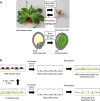Unravelling the molecular network of desiccation tolerance in resurrection plants started with the model plant Craterostigma plantagineum
- PMID: 40560488
- PMCID: PMC12198318
- DOI: 10.1007/s00425-025-04752-8
Unravelling the molecular network of desiccation tolerance in resurrection plants started with the model plant Craterostigma plantagineum
Abstract
Molecular studies of desiccation-tolerant resurrection plants identified major components for surviving severe water depletion of vegetative tissues. The research also highlights potential applications for crop protection during drought. The ability of vegetative plant tissues to withstand desiccation is a property of a small group of resurrection plants specific to specialized ecological niches. In the 1980s, studies on these plants were limited to the physiological and morphological levels. However, in 1990, a study by Bartels et al. using the South African resurrection plant Craterostigma plantagineum was the first to address desiccation tolerance at the molecular level. A differential screening approach with C. plantagineum leaves and callus pretreated with ABA led to the identification of transcripts that were upregulated by desiccation. Many of the identified genes encoded late embryogenesis-abundant (LEA) proteins, which are abundant proteins that accumulate during normal seed development. Therefore, the study confirmed that the acquisition of desiccation tolerance in vegetative tissues of resurrection plants partially involves the seed maturation programme involving ABA. Subsequent research with C. plantagineum contributed to elucidating the gene regulatory networks and metabolic changes that contribute to desiccation tolerance and provided the basis for studies with other resurrection species. More recently, the genomes of C. plantagineum and several other resurrection plants have been sequenced, which has allowed comparative genomics approaches to identify conserved mechanisms and signatures associated with vegetative desiccation tolerance. A primary goal remains to transfer existing knowledge from resurrection plants to genetically engineer drought tolerance in crop plants, which will improve survival during periods of drought and will maintain future food security despite increasing impacts of climate change.
Keywords: Abscisic acid; Evolution of desiccation; LEA proteins; Seed desiccation tolerance; Vegetative desiccation tolerance.
© 2025. The Author(s).
Conflict of interest statement
Declarations. Conflict of interest: The authors declare that they have no conflicts of interest related to this work.
Figures


Similar articles
-
Seed desiccation mechanisms co-opted for vegetative desiccation in the resurrection grass Oropetium thomaeum.Plant Cell Environ. 2017 Oct;40(10):2292-2306. doi: 10.1111/pce.13027. Plant Cell Environ. 2017. PMID: 28730594
-
What can we learn from the transcriptome of the resurrection plant Craterostigma plantagineum?Planta. 2015 Aug;242(2):427-34. doi: 10.1007/s00425-015-2327-z. Epub 2015 May 22. Planta. 2015. PMID: 26002527 Review.
-
Retrotransposons and siRNA have a role in the evolution of desiccation tolerance leading to resurrection of the plant Craterostigma plantagineum.New Phytol. 2008;179(3):877-887. doi: 10.1111/j.1469-8137.2008.02480.x. Epub 2008 May 13. New Phytol. 2008. PMID: 18482228
-
A Group 6 LEA Protein Plays Key Roles in Tolerance to Water Deficit, and in Maintaining the Glassy State and Longevity of Seeds.Plant Cell Environ. 2025 Sep;48(9):6874-6896. doi: 10.1111/pce.15649. Epub 2025 Jun 5. Plant Cell Environ. 2025. PMID: 40474454 Free PMC article.
-
Molecular mechanisms of desiccation tolerance in resurrection plants.Cell Mol Life Sci. 2012 Oct;69(19):3175-86. doi: 10.1007/s00018-012-1088-0. Epub 2012 Jul 26. Cell Mol Life Sci. 2012. PMID: 22833170 Free PMC article. Review.
References
-
- Alcantara S, de Mello-Silva R, Teodoro GS, Drequeceler K, Ackerly DD, Oliveira RS (2015) Carbon assimilation and habitat segregation in resurrection plants: a comparison between desiccation- and non-desiccation-tolerant species of Neotropical Velloziaceae (Pandanales). Funct Ecol 29:1499–1512. 10.1111/1365-2435.12462
-
- Alpert P (2000) The discovery, scope, and puzzle of desiccation tolerance in plants. Plant Ecol 151:5–17. 10.1023/A:1026513800380
-
- Amara I, Capellades M, Ludevid MD, Pagès M, Goday A (2013) Enhanced water stress tolerance of transgenic maize plants over-expressing LEA Rab28 gene. J Plant Physiol 170:864–873 - PubMed
-
- Banerjee A, Roychoudhury A (2016) Group II late embryogenesis abundant (LEA) proteins: structural and functional aspects in plant abiotic stress. Plant Growth Regul 79:1–17. 10.1007/s10725-015-0113-3
-
- Bartels D (2005) Desiccation tolerance studied in the resurrection plant Craterostigma plantagineum. Integr Comp Biol 45:696–701. 10.1093/icb/45.5.696 - PubMed
Publication types
MeSH terms
Substances
LinkOut - more resources
Full Text Sources

